“], “filter”: { “nextExceptions”: “img, blockquote, div”, “nextContainsExceptions”: “img, blockquote, a.btn, a.o-button”} }”>
New perk: Easily find new routes and hidden gems, upcoming running events, and more near you. Your weekly Local Running Newsletter has everything you need to lace up!
>”,”name”:”in-content-cta”,”type”:”link”}}”>Subscribe today.
It’s not uncommon for those of us who run to consider tight hamstrings as a point of pride. Although tension in the hamstrings can make for efficient energy transfer as you run, it’s not exactly a testament to your athleticism. Too much hamstring tension can create pain in your hips, back, and elsewhere in your legs, which can sideline you from the very thing you do. The solution, which you’ve no doubt been told countless times before, is to incorporate some hamstring stretches for runners into your cool down.
These strong muscles along the back of your thighs work to bend your knee and extend your hip—critical movements for your running stride. Stretching can help you navigate the demands running places on your body with more ease—and without won’t diminishing your hamstring strength.
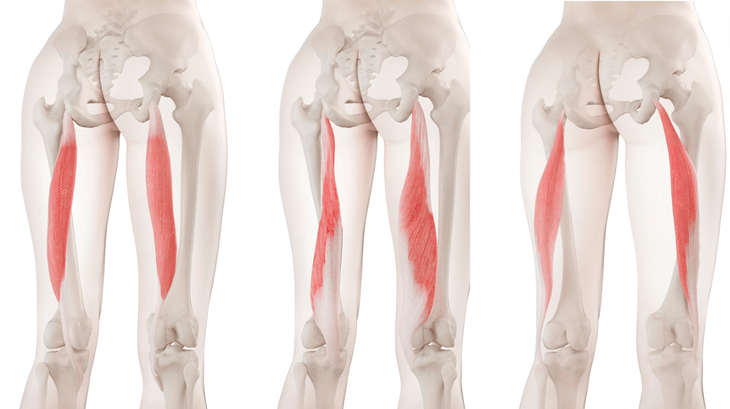
The Simplest Way to Approach Hamstring Stretches for Runners
While you are likely used to pushing yourself in training—that’s what makes you a good runner, after all—you need to take the opposite approach on the mat. Aggressively stretching your hamstrings can apply too much stress to your high hamstring tendons, which connect the hamstrings muscles to your sitting bones. That can lead to tendinopathy, a literal pain in your butt that can take a frustratingly long time to heal.
It can also lead less obvious tears and strains that you won’t feel in the moment but can derail you later—especially when you suddenly change pace, like when you sprint for the finish line.
The aim is to know when enough is enough and be okay with that. Yoga can help with that—both with self-awareness and stretching. You don’t need to get your foot behind your head in order to be flexible enough. In fact, that’s probably counterproductive. What many of us misunderstand about flexibility is that if you focus on getting as far as possible in your forward folds, you’re probably missing out on some essential tension and springiness that makes you a good runner.
In yoga, we refer to this elusive balancing act as “sthira” and “sukha,”often explained as “effort” and “ease.” The concept actually plays out in every aspect of your life, but when it comes to running, you could think of it as a balance between stability and mobility, strength and flexibility.
Think through how much flexibility you need for your workouts. If you’re a hurdler, it’s going to be a lot more hamstring stretching for you to clear the obstacle than if you’re a distance runner. If you’re the latter, you might need enough flexibility to get your shoes tied with your knees bent and no more!
So try them, explore some of the variations, and see what works best for you. And don’t forget to know when enough is enough.
RELATED: Yoga for Runners: 3 Essential Stretches
7 Best Hamstring Stretches for Runners
Try a few of these stretches after your workouts. Lingering for five to 15 breaths in each of these stretches will be plenty of time.
In terms of how intense the stretch should be, think of it as enough to keep you from getting bored but not so strong you want to cry! There should be no pain associated with these stretches. If there is, consult your health care provider.
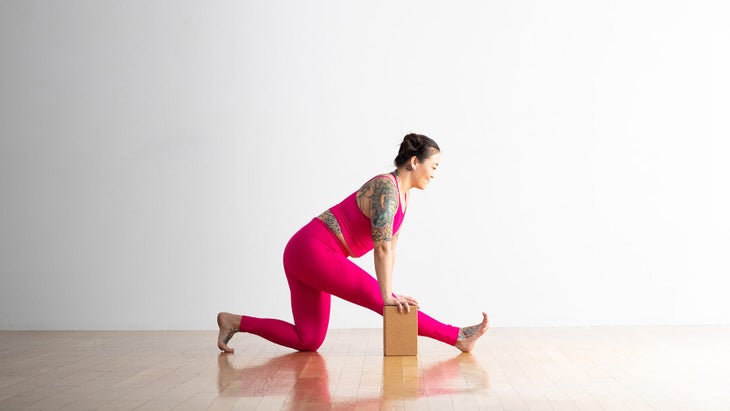
1. Runner’s Lunge
Why It’s Helpful for Runners: It targets all the hamstrings of the front leg, so don’t forget to switch sides.
How To: From Low Lunge, shift your hips back slightly as though you’re resting all your weight on your back leg and start to take your front knee toward straight-ish.
Variations: Point your toes away from you to stretch the top of your ankle. Then try rolling to the back of your front heel to work your calf muscles. For less intensity, place blocks underneath your hands and experiment to find the correct amount of bend in your front knee.
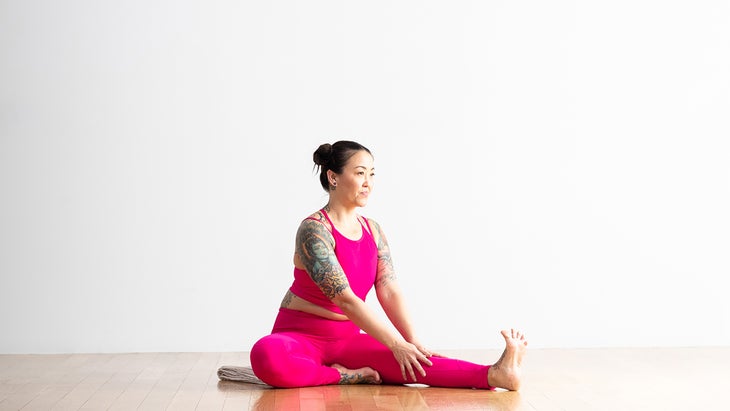
2. Head-to-Knee Pose
Why It’s Helpful for Runners: This asymmetrical head-to-knee fold focuses on one leg at a time while stretching the muscles that connect your pelvis and spine and that run up the length of your back. This lets you pay careful attention to each leg as its own experience.
How to: From sitting, straighten your left leg in front of you and bend your right leg, taking the bottom of your right foot against the inner thigh of your left leg. Fold forward over your straight leg, resting your left hand on your thigh, shin, or foot.
Variations: The placement of your bent knee will affect the stretch for your back. If it’s hovering in space, support it by sliding a block, folded blanket, or pillow beneath your knee. To stretch your back more, try sliding your bent knee a few inches back and farther to the left.
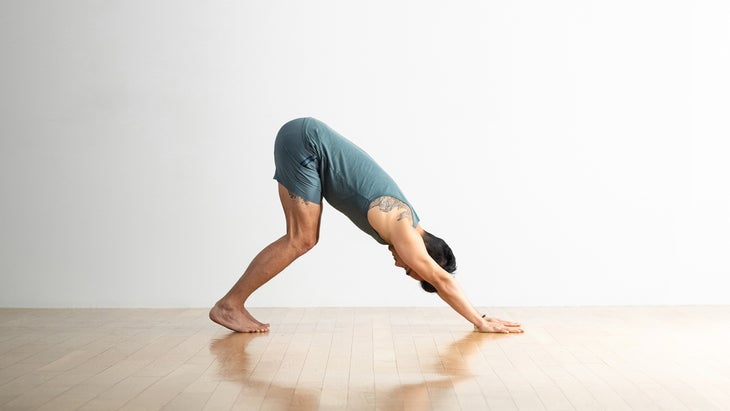
3. Downward-Facing Dog
Why It’s Helpful for Runners: Downward-Facing Dog stretches both hamstrings simultaneously, which can highlight any differences between your right and left sides. It also allows you a lot of room to modify so you can find an intensity, or edge, that’s appropriate without overdoing it.
How to: From hands and knees, tuck your toes and press down through your hands as you lift your hips up and back as you straighten your legs to create an inverted V with your body. Your heels won’t necessarily touch the mat!
Variations: For less pressure on your hamstrings, keep a deep bend in your knees and let your heels stay lifted off the mat. For less pressure on your upper body, practice Down Dog standing against a wall, a counter, or a chair back.
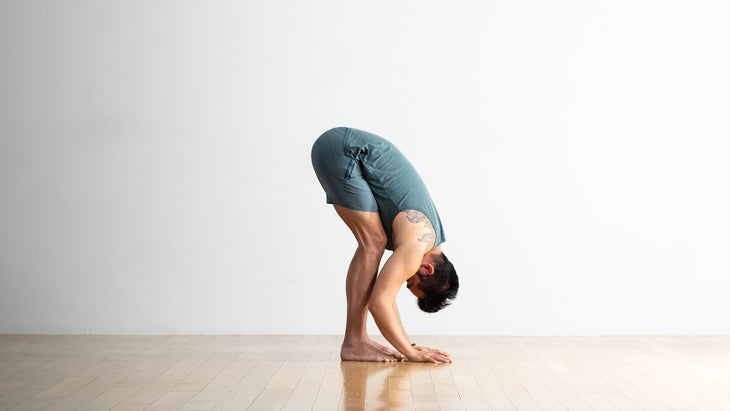
4. Standing Forward Fold
Why It’s Helpful for Runners: In this type of forward fold, the stretch is centered in the middle of your hamstrings. The longer you hang out in this stretch—spend more than three breaths, and less than three minutes—the more likely you are to counteract some of the tightness your running incurs.
How to: Keep your feet together or approximately hip-distance apart with your toes facing forward. Tilt forward from your pelvis (don’t lean from your waist, which stretches your back, not your hamstrings). Rest your hands anywhere on your legs or blocks or a coffee table—you don’t need to reach your feet. Your head and neck can let go. Bend your knees as much as you need.
Variations: Rather than hold yourself tense in this standing forward fold, you’ll feel gravity help release your back body. Let it.
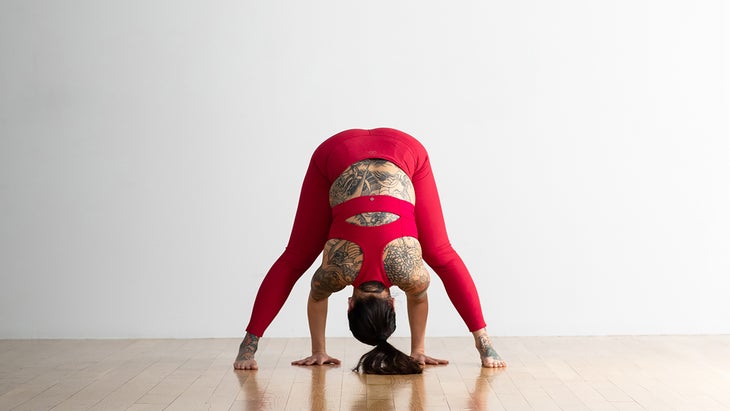
5. Standing or Seated Wide-Legged Forward Fold
Why It’s Helpful for Runners: Taking your legs into a straddle changes the area affected by the forward fold, moving the stretch into your inner hamstrings and inner thighs.
How to: Move your legs as far apart as feels reasonable and hinge forward from your hips. Don’t try to force the stretch by rounding your back, unless you also enjoy the stretch in your back. When your back rounds, you lose the focus on your hamstrings. And yes, this means you might not “fold” much at all—and that’s okay! Remember, tense and springy hamstrings are necessary for good running.
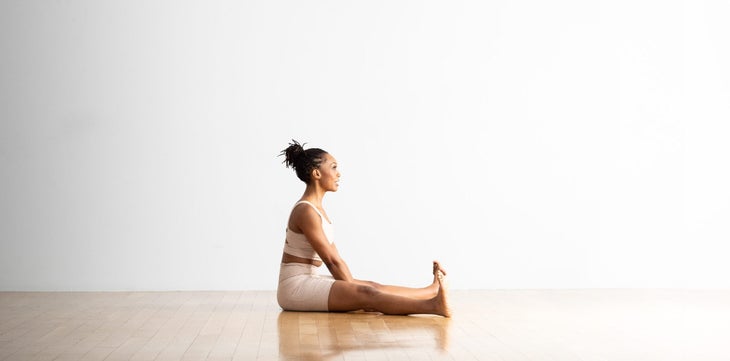
Variations: If you practice the forward bend while standing, you can keep your hands beneath your shoulders with your fingertips in line with your toes. Or you can choose to walk your hands forward, walk them between your legs and behind you, or clasp your hands and interlace your fingers behind your back.
In either the standing or the seated version of this wide forward fold, you can shift where you feel the stretch by adding a slight twist. Simply reach both hands toward one leg at a time.

6. Reclined Hand-to-Strap Hamstring Stretch
Why It’s Helpful for Runners: Stretching this muscle group while reclined enables you to take any balancing or strengthening out of the equation and simply focus on stretching.
How to: Lie on your back with your knees bent and your feet on the mat. Loop the strap around the ball of your right foot. Slowly reach your right foot toward the ceiling, keeping your shoulders, neck, and head relaxed and grounded. Draw your right leg toward your chest whatever amount is reasonable for you.
Variations: You can work to stretch each of your hamstring muscles by moving the position of your leg a few inches in either direction. To stretch your outer hamstrings, which interface with your IT band, move your right leg toward the left side of your body while keeping your right hip down. To stretch your inner hamstrings, which interface with your adductors (inner thigh muscles), take your right foot toward the right a few inches while keeping your hips steady.
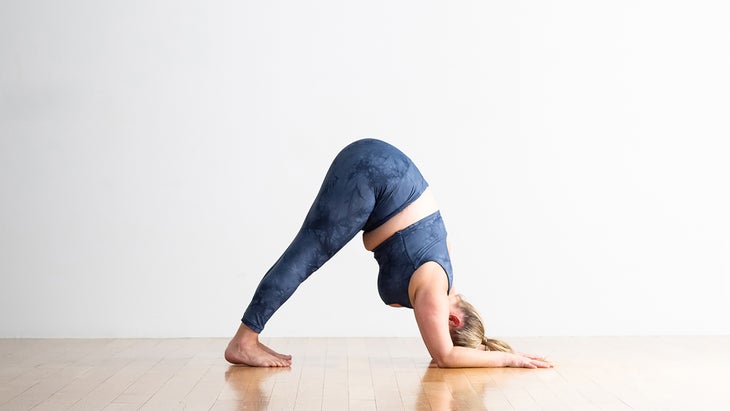
7. Dolphin Pose
Why It’s Helpful for Runners: In addition to stretching the hamstrings, this variation on Downward-Facing Dog also builds upper-body strength and flexibility, something that running doesn’t address.
How to: From hands and knees, place your forearms on the mat, shoulder distance apart, as you would for Forearm Plank, either parallel to each other or on a diagonal with your hands clasped in the center. Lift your hips into an inverted V as you would in Down Dog and walk your feet toward your hands until you feel an appropriately interesting stretch—but no pain—along the backs of your legs.
Variations: You can change the angle—and, therefore, the intensity and sensation—of the stretch by resting your forearms on blocks or practicing the stretch while standing and leaning your forearms against a wall.
